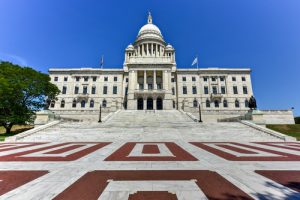Rhode Island State House
Every Christmas, magic happens at the Rhode Island State House. Every year, a family donates a tree that is cut, cleaned, and shipped to the iconic statehouse and positioned in the middle of the rotunda for all to see. It is a tradition to go and view the tree with its local decorations and glad tidings. Although the Christmas traditions (and trees) have evolved and changed over the years with ebbing cultural trends, the Rhode Island State House remains standing; a symbol of strength and beauty for past, current, and future generations.
Erected in Neoclassical flair by the Architectural group Mckim, Meade, and White, the ornate and opulent Rhode Island State House is the envy of many larger territories that do not boast such a spectacular structure. This is currently the capital site of Rhode Island and houses the Rhode Island General Assembly, and other state offices such as the Governor’s office. The structure is massive and holds the record for the 4th largest self-supported marble dome structure in the world. 
A symbol of patriotism, the ‘Independent Man’ is a legacy that sits atop the building. The building began construction in 1894 with completing in 1904. In 1899, George Brewster designed the 11-foot tall man that is perched atop the center dome. The structure has only left its outlook post once in the 1970s for a small repair on a gold leaf. He has originally named ‘Hope’ and his presence represents freedom and independence.
Also within the confines of this magnificent structure is an ornately decorated library. Initially, the brightness of the room is what is noticed. With its gold leafing and overlay’s, the ceiling seems to be illuminated from within. Gold leaf and plaster reproductions of over 500 printer marks are used as the pattern for the ornate designs fitting nicely into the overall theme of the room.
Most Americans have seen the famous Gilbert Stewart painting of George Washington, but few know that it is housed right here in the Rhode Island State House. Also housed here is a replica of the famous Liberty Bell. Complete with a crack etched on the bell modeled after the original, this bell is one you can experience firsthand and even touch. It gives one an idea of the grandeur of the original while making it also an accessible piece of history.
A very famous debate of the time centered around Roger William’s conviction that government should have no part in religious decisions or governance and should be removed from consideration in the secular arena. Williams sought solace in a land free from the tyrannical religious rule of the day and his ideals saw fruition in the place of the Rhode Island State House. The debate of the day raged on and eventually came to a ‘conclusion’ at the reign of King Charles II where he declared that no persons in Rhode Island shall be ‘punished’ or ‘put upon’ for differences of religion. This was truly a revolutionary idea the history is all contained in the Rhode Island State House.
William was persecuted relentlessly for his ideals and lived a disquieted life. With his efforts, however, Rhode Island becomes among the first to declare its ‘separation of church and state’ mantra (which, consequently, is not found in the constitution but, rather, phrasing from a letter Thomas Jefferson sent to the Danbury Baptist Association ensuring them that the yolk of religion is not to be forced upon the people by the government).
The King of the day sealed this declaration by inscribing the royal charter on sheep’s skin (the material used at the time for such documents). Due to the expansion and contraction of the material by atmospheric activity, the original charter is protected, but still on-site to be observed at the Rhode Island State House.
The rich history, architecture, and beauty of the Rhode Island State House is a fitting memorial to the state of Rhode Island. Being one of the original 13 colonies, Rhode Island deserves a monument fitting of its status among the other, albeit larger, states. A small state with a magnificently grand statehouse that has stood the test of time. It remains as a monument and testimony to freedom and independence for all.

